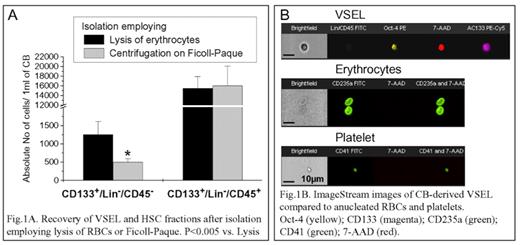Abstract
Several lines of evidence support the hypothesis that pluripotent stem cells (PSCs) reside in human tissues. Recently, we identified a population of very small embryonic-like (VSEL) SCs in umbilical cord blood (CB) (
Leukemia 2007;21:297-303
). These VSELs are: i) very small in size (<6 um); ii) SSEA-4+/Oct-4+/CD133+/CD34+/CXCR4+/Linneg/ CD45neg; iii) responsive to a stromal derived factor (SDF)-1 gradient; and iv) possess large nuclei that contain primitive euchromatin. In the current study, we optimized their isolation/purification strategy and employed several imaging and molecular techniques to better analyze these primitive cells. We noticed that because of their small size, CD133+/ Linneg/CD45neg VSELs are lost (42.5±12.6%) during routine CB unit processing by volume depletion before storage/freezing. Interestingly, these cells are more resistant to changes following freezing and thawing as compared to normal hematopoietic (H)SCs. Interestingly, 82.7±17.3% of the initially frozen CD133+/Linneg/CD45neg VSELs are preserved in frozen CB units, while only 65.0±6.1% CD133+/Linneg/CD45neg HSCs are recovered. Furthermore, when we employed Ficoll centrifugation to purify CB mononuclear cells (CB MNCs), we found that while 59.8±7.2% of CD133+/Linneg/CD45neg VSELs were lost, their hematopoietic counterparts (CD133+/Linneg/CD45+) were almost fully recovered (Fig. 1A). These data indicate that other more “VSEL-saving” strategies of erythrocyte depletion should be developed because of the unusual size and density of these cells. We also established that the most the optimal “VSEL-saving” strategy to deplete erythrocytes from CB was hypotonic lysis. However, we noticed that during this procedure, lyzed erythrocytes release phosphatidyloserine positive (PS+) membrane-derived microvesicles (MVs) and these PS+ MVs preferentially bind to VSELs. Because of this phenomenon, VSELs become PS+ and may be falsely recognized as apoptotic cells in the Annexin-V-binding assay. The unique morphological features of VSELs were confirmed by several complementary imaging methods. ImageStream analysis revealed that VSELs are smaller than erythrocytes, are larger than platelets, and posses a high nuclear/cytoplasmic ratio (Fig. 1B). The fraction of CD133+/Linneg/CD45neg) VSELs with the smallest size (<6 um) exhibit a high cytoplasmic nuclear ratio and highly express Oct-4 in the nucleus and SSEA-4 and CD133 antigens on the surface. Finally, we found 2 to 3 times higher numbers of VSELs in CB samples from vaginal deliveries as compared to scheduled C-sections. This supports the idea that VSEL are released into CB due to delivery-related stress/hypoxia. In conclusion, CB contains a population of VSELs but ~50% of these cells are not recovered by currently employed volume-reduction strategies because of their unique morphology. Taking into consideration that VSELs may be employed in regenerative medicine, novel volume reduction/erythrocyte depletion strategies require development in CB banking to avoid loss of these rare, primitive, and important cells.Disclosures: No relevant conflicts of interest to declare.
Author notes
Corresponding author
2008, The American Society of Hematology
2008


